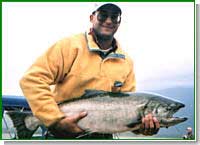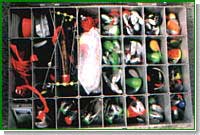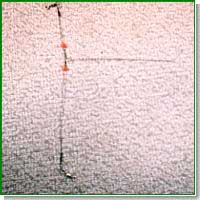Chinook Fishing on the Fraser River
Chinook Fishing on the Fraser River
By Vic Carrao
The first salmon to begin migrating up the Fraser River is the Chinook salmon. Chinook salmon are the largest of the 5 species of pacific salmon that use the Fraser River, as it's migratory highway. Chinook salmon began their migration as early as March continuing through until late November. During this time there are many distinct runs that make up the entire population of Fraser Chinook. Many of the rivers that flow into the Fraser have their own distinct stocks of Chinook; these fish will vary in size and genetics from other stocks that also use the Fraser. The size of these fish will vary from stock to stock; the average size is between 18 -25 lbs with good number of fish in the 25 to 35 lb range.  The most popular method used for catching Chinook salmon is bar fishing. Bar fishing is quite simple, you find yourself a nice gravel or sand bar, make sure you have a lawn chair, umbrella for rain or shade from the hot sun, cooler with some lunch and beverages and your set. The tackle use for bar fishing is very simple, rod, reel, rod holder, weights and lures. Well maybe the tackle is not quite that simple but close. The most popular method used for catching Chinook salmon is bar fishing. Bar fishing is quite simple, you find yourself a nice gravel or sand bar, make sure you have a lawn chair, umbrella for rain or shade from the hot sun, cooler with some lunch and beverages and your set. The tackle use for bar fishing is very simple, rod, reel, rod holder, weights and lures. Well maybe the tackle is not quite that simple but close. Equipment used for bar fishing consists of a medium to medium heavy rod, 10 to 12 ft with a line rating of 12-30 lbs capable of casting up to 20 oz of lead. There are two types of rods primarily used, a large spin cast /surf rod or heavy bait cast rod. Some of the more common spin cast rods are the Shimano 12 ft surf rods and the 11 to 13 ft Shakespeare Ugly stick. For those who prefer a levelwind with a bait cast rod I would recommend the 11 ft Abu Garcia Concord or the 11 ft Trophy Fraser River King. Reels should be capable of holding a minimum of 200 yards of 25 lb test, the Abu Garcia 7000 is very nice, Quantum makes several sizes that would apply and Penn makes a nice reel which is very affordable, the Penn 320 or 321(left hand) is durable and can be used for sturgeon as well. The rigging most anglers use is very simple, I prefer to use a 6 or 8 inch spreader bar attached to the mainline, a piece of 6 inch mono tied to the bottom with a snap swivel attached to a piece of lead. Attached to the spreader bar is a leader of 36 to 40 inches with a # 2, #0, or #00 spin n glo. This rigging is effective in most areas of the Fraser although anglers who frequent the lower river below Mission bridge make some slight changes to the bar rig and most prefer to use cured salmon roe with or without a spin n glo. Many of the local tackle stores will sell these bar rigs already made up and ready to use. Spin n glo's  Like many fisheries in British Columbia, local anglers will develop methods that best suite the conditions of that particular area. I'm not really sure who started bar fishing first or who began using spin n glo's on the Fraser, but over the years certain color patterns have been developed that produce the best results. Color patterns used for the Fraser depends on the targeted species, over the years I have found that one color will out produce another, time and time again. Water clarity does play a role but not as much as you would think. Only when visibility is at it's poorest I change over to darker colors. Like many fisheries in British Columbia, local anglers will develop methods that best suite the conditions of that particular area. I'm not really sure who started bar fishing first or who began using spin n glo's on the Fraser, but over the years certain color patterns have been developed that produce the best results. Color patterns used for the Fraser depends on the targeted species, over the years I have found that one color will out produce another, time and time again. Water clarity does play a role but not as much as you would think. Only when visibility is at it's poorest I change over to darker colors. If you were to survey 10 avid steelhead anglers for their number one lure you would probably get 10 different answers. If you were to survey 10 avid Fraser River Bar fishermen for their favorite color of lure you would get 2 answers. I know that there are many colors that catch fish, but if you wanted the most consistent, don't leave home with out them type lures, you would have to pick the red cap/chrome and green cap /chrome. These two colors are by far the most consistent producers on the Fraser for early Chinook. When the water clarity becomes poorest I like to use the same lures but with some black added to either the wings or a black scale added to the body. Several years ago some new larger sizes came out onto the market. You can now purchase some of the more popular colors in a 2/0 and 3/0, the only downfall to the larger sizes is the wings tend to break easier than on the smaller sizes. Tips and Tricks Over the years when water clarity was at it's poorest, anglers would try making small changes to the spin n glo's to increase their chances. Some anglers swear by the changes, others aren't really sure, the way I look at it, if it doesn't decrease the chances then what the heck, why not? I'm not sure who started this one but I think it may have been a long time Fraser River Angler Ken Kristians. Ken spent most of his time on the river paying close attention to smallest of details, whether it was salmon or sturgeon Ken always seemed to hook the biggest and the most. If Ken was using it, it was probably worth a try. Spin n glo's come with 2 styles of wings, Mylar and rubber, Mylar being the more popular of the two. When the spin n glo is placed in the water, the pressure from the water turns the wings creating turbulence and vibration. Most anglers feel it's the vibration combined with the color that attracts the aggressive hits from migrating salmon. There are two tricks that I have learned that increase the turbulence and vibration of the spin n glo. The first one is placing a hole in one of the wings with a hole punch. This trick is used to put the spin n glo off balance, creating more vibration. The second trick is to drill the hole larger and on a slight angle that runs through the center of spin n glo. Once again, this puts the lure off balance creating more turbulence or vibration. Weights Before lead weights were available in the heavier sizes most Fraser River bar fishermen used the loose railway spikes found along the tracks. You could use the spike itself or the heavier pin used to hold down the rail. This method is still used by a few local anglers and anglers who fish the upper Fraser where the river bottom is made up of large stones. This type of river bottom is sure to snag up your weights so using a railway spike was sensible and affordable especially back in the old days when money and fishing tackle was a little more scarce. What they would do is attach a light leader of 8 or 10 lb test from their bar rig to the spike. Once cast out into the river the spike would hold in the current much the same as lead would today. Once the fish hit the lure, the light leader attached to the spike would break leaving the angler to do battle with the fish with out the weight. If the angler wanted to check his lure he would pull up hard on the line, breaking the line to the spike, retrieving the lure only, leaving the spike on the river bottom. He would then tie on another spike and recast.  Today, there are 2 styles of weights used for bar fishing on the Fraser, pyramid and wedge. Both are made from lead but have a slightly different shape which best suite a particular type of river bottom. I prefer wedge weights for gravel bottoms and pyramid for a sand bottom. The wedge weights seem to bounce the river bottom less leaving the corners squarer longer, making for a better hold. Today, there are 2 styles of weights used for bar fishing on the Fraser, pyramid and wedge. Both are made from lead but have a slightly different shape which best suite a particular type of river bottom. I prefer wedge weights for gravel bottoms and pyramid for a sand bottom. The wedge weights seem to bounce the river bottom less leaving the corners squarer longer, making for a better hold. The amount of lead used is directly related to depth and the current, this is where having the appropriate equipment comes into play. If anglers around you are using 18 to 20 oz of lead, then you must use the same amount of lead to keep from tangling up the lines. If you were to use 12 oz in this situation your lead would not hold and would walk down the river tangling with other anglers. Once you've cast the lure out into the river, just set your rod into a rod holder and wait. The heavier the weight the faster of current it will hold in. Tips and tricks Most of the popular bars fished for Chinook will have what I call a travel lane. Local anglers will know how far out to cast at various water levels to find the travel lane of migrating fish. In order to hold your lure in these travel lanes you will need to know how much weight to use. If you use too much your lure will hold too far out, if you use too light of weight your lure will bounce through the travel lane holding too close in. Always check too see what other anglers are using for weight and how far they are casting. If your on a bar without other anglers, change your casting distance and weight every couple of hours until you hit a fish, then take note on the water level, current rate, amount of weight and how far you cast. Rod holders Rod holder's come in many shapes & sizes, I've found the better ones are usually made by the angler himself or by someone they know who has access to cheap material and a welding machine. The only real requirement is that the rod holder shaft be long enough to spike into the gravel a couple of feet and still have enough shaft to keep the rod clear above the water. I prefer a 4 ft shaft with a 1 ft tube to hold the rod. If you don't have access to a welding machine, take a piece of 4 or 5 ft angle iron, attach 1 ½ inch pvc tubing with either bolts or clamps and your set. Many anglers attach a cowbell to the rod so that when a fish hits the bell rings. It can drive you nuts trying to watch your rod tip all day not to mention the sore neck. Attaching a bell will allow you some freedom to move around the area while still being aware if a fish grabs your lure. It makes for a great day with the family when you can throw your lines out, and then go on an adventure with your kids. My girls love to hunt for agates and jade and go for hikes into the wooded areas. One word of caution, it is considered taboo or even rude to ring your bell. When you're handling the bell, place a finger into the bell to stop the ringing. The only time your bell should ring is when a fish is doing the ringing. Location There are many productive bars to fish on the Fraser for salmon. Bar fishing is one of my favorite fisheries, not for productivity but for piece and quite, meeting new people and just spending some quality time relaxing with my family and friends. I have met many great people on the bars of the Fraser, many people who have fished the Fraser long before you or I were born. If you decide to try bar fishing the Fraser, bring your best foot forward, listen to the old timers, leave all your troubles at home and please leave the Vedder River mentality behind. The Fraser River offers great angling, great scenery and most of all great people.
|
